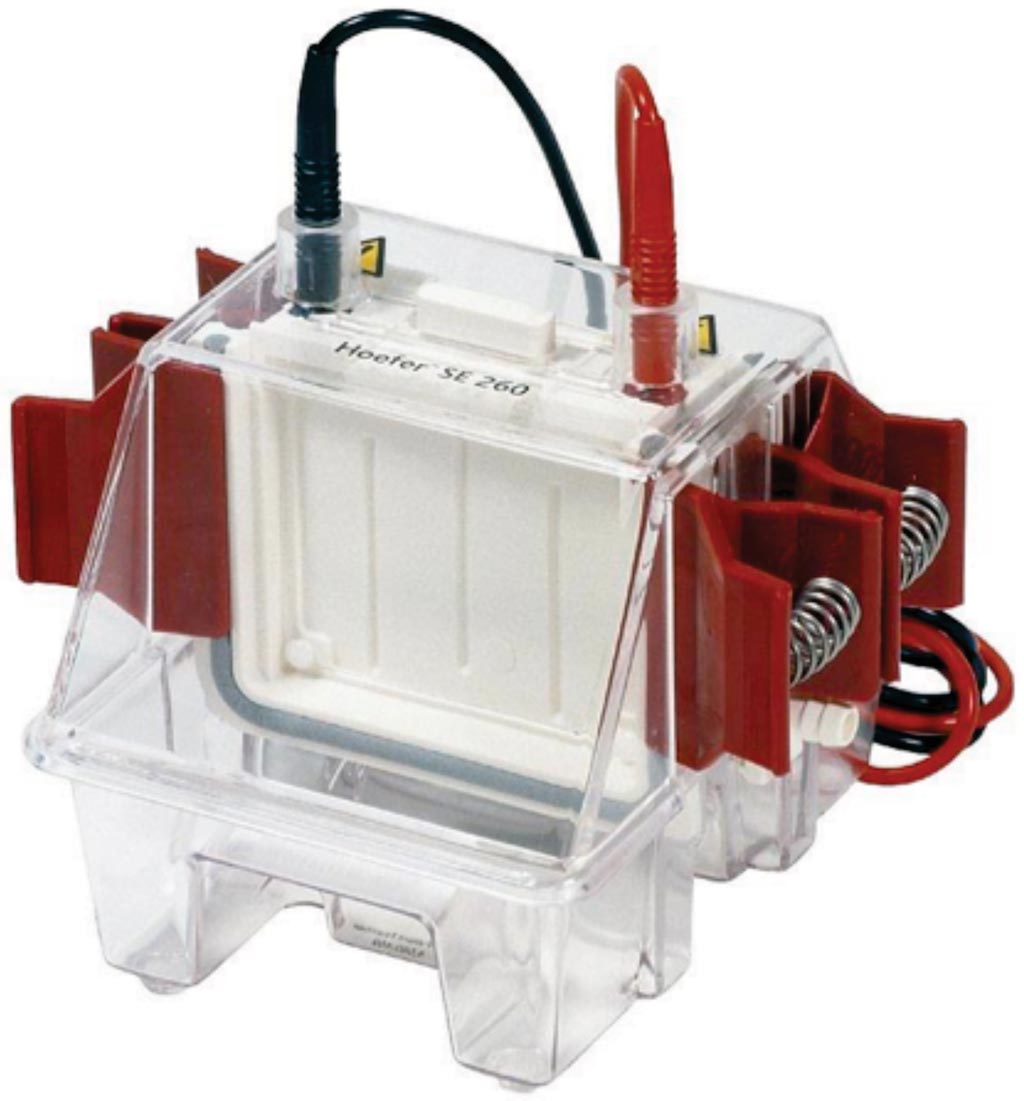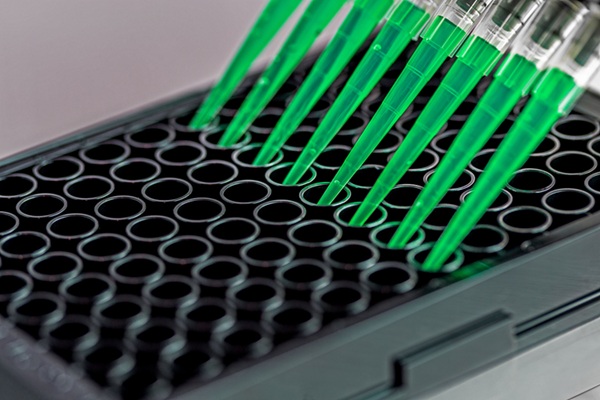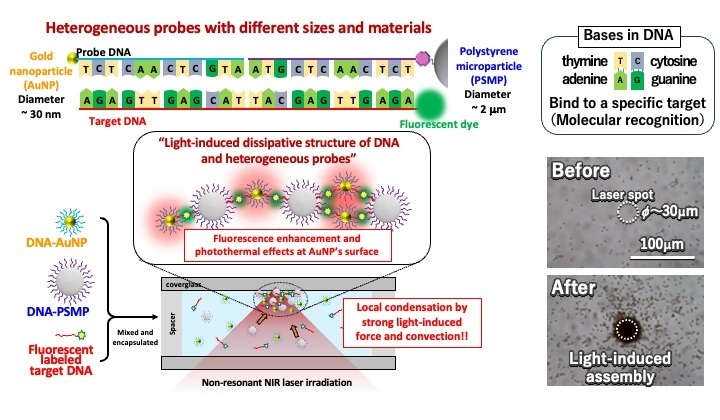Troponin Complexes Explored in Acute MI Patients
|
By LabMedica International staff writers Posted on 22 Aug 2019 |

Image: The SE280 electrophoresis unit (Photo courtesy of Hoefer).
Acute myocardial infarction is the medical name for a heart attack. A heart attack is a life-threatening condition that occurs when blood flow to the heart muscle is abruptly cut off, causing tissue damage. This is usually the result of a blockage in one or more of the coronary arteries.
The troponin complex is a component of the contractile apparatus of striated and cardiac muscles. The measurement of cardiac isoforms of troponin I (cTnI) and troponin T (cTnT) is widely used for the diagnosis of acute myocardial infarction (AMI). In the heart, these cardiac troponin complexes are composed of these specific cardiac isoforms and a cardiac/slow skeletal isoform of troponin C (TnC). On acute myocardial infarction (AMI), troponins are released from necrotic tissue into the bloodstream.
A team of scientists linked up with those at the commercial company HyTest Ltd (Turku, Finland) collected serial blood samples from 38 patients (148 samples in total) were collected between 2 and 33 hours following the onset of chest pain. Blood was withdrawn by means of venipuncture into 10-mL vacutainer blood-collection tubes coated with Li-heparin. Tubes were inverted several times and centrifuged for 20 minutes at 1500g. The resulting plasma was decanted and stored at −70 °C in 5-mL polypropylene tubes. Heparin plasma samples from 11 apparently healthy individuals, 25 to 40 years of age, were pooled and stored at −70 °C.
The team measured cTnI and cTnT concentrations in all Li-heparin plasma samples were measured by in-house immunofluorescence assays (FIA) utilizing TnI19C7-TnI560 and TnT329-TnT406 assays, respectively. All samples were analyzed by a 2-step FIA using Eu-labeled monoclonal antibodies (mAbs). They also conducted “mixed sandwich assays” in which capture and detection mAbs were specific to different components of troponin complexes. The gel filtration (GF) studies were performed using an AKTA pure chromatography system on a HiLoad Superdex 200 PG 16/60 column. Cardiac troponins and their fragments were analyzed using 15% to 22.5% gradient SDS-PAGE according to Laemmli under reducing conditions using a Hoefer SE280 electrophoresis unit.
Plasma samples from patients with AMI contained the following troponin complexes: (a) a cTnI-cTnT-TnC complex (ITC) composed of full-size cTnT of 37 kDa or its 29-kDa fragment and full-size cTnI of 29 kDa or its 27-kDa fragments; (b) ITC with lower molecular weight (LMW-ITC) in which cTnT was truncated to the 14-kDa C-terminal fragments; and (c) a binary cTnI-cTnC complex composed of truncated cTnI of approximately 14 kDa.
During the progression of the disease, the amount of ITC in AMI samples decreased, whereas the amounts of LMW-ITC and short 16- to 20-kDa cTnT central fragments increased. Almost all full-size cTnT and a 29-kDa cTnT fragment in AMI plasma samples were the components of ITC. No free full-size cTnT was found in AMI plasma samples. Only 16- to 27-kDa central fragments of cTnT were present in a free form in patient blood.
The authors concluded that a ternary troponin complex exists in two forms in the blood of patients with AMI: full-size ITC and LMW-ITC. The binary cTnI-cTnC complex and free cTnT fragments are also present in patient blood. The study was published on the July 2019 issue of the journal Clinical Chemistry.
Related Links:
HyTest
The troponin complex is a component of the contractile apparatus of striated and cardiac muscles. The measurement of cardiac isoforms of troponin I (cTnI) and troponin T (cTnT) is widely used for the diagnosis of acute myocardial infarction (AMI). In the heart, these cardiac troponin complexes are composed of these specific cardiac isoforms and a cardiac/slow skeletal isoform of troponin C (TnC). On acute myocardial infarction (AMI), troponins are released from necrotic tissue into the bloodstream.
A team of scientists linked up with those at the commercial company HyTest Ltd (Turku, Finland) collected serial blood samples from 38 patients (148 samples in total) were collected between 2 and 33 hours following the onset of chest pain. Blood was withdrawn by means of venipuncture into 10-mL vacutainer blood-collection tubes coated with Li-heparin. Tubes were inverted several times and centrifuged for 20 minutes at 1500g. The resulting plasma was decanted and stored at −70 °C in 5-mL polypropylene tubes. Heparin plasma samples from 11 apparently healthy individuals, 25 to 40 years of age, were pooled and stored at −70 °C.
The team measured cTnI and cTnT concentrations in all Li-heparin plasma samples were measured by in-house immunofluorescence assays (FIA) utilizing TnI19C7-TnI560 and TnT329-TnT406 assays, respectively. All samples were analyzed by a 2-step FIA using Eu-labeled monoclonal antibodies (mAbs). They also conducted “mixed sandwich assays” in which capture and detection mAbs were specific to different components of troponin complexes. The gel filtration (GF) studies were performed using an AKTA pure chromatography system on a HiLoad Superdex 200 PG 16/60 column. Cardiac troponins and their fragments were analyzed using 15% to 22.5% gradient SDS-PAGE according to Laemmli under reducing conditions using a Hoefer SE280 electrophoresis unit.
Plasma samples from patients with AMI contained the following troponin complexes: (a) a cTnI-cTnT-TnC complex (ITC) composed of full-size cTnT of 37 kDa or its 29-kDa fragment and full-size cTnI of 29 kDa or its 27-kDa fragments; (b) ITC with lower molecular weight (LMW-ITC) in which cTnT was truncated to the 14-kDa C-terminal fragments; and (c) a binary cTnI-cTnC complex composed of truncated cTnI of approximately 14 kDa.
During the progression of the disease, the amount of ITC in AMI samples decreased, whereas the amounts of LMW-ITC and short 16- to 20-kDa cTnT central fragments increased. Almost all full-size cTnT and a 29-kDa cTnT fragment in AMI plasma samples were the components of ITC. No free full-size cTnT was found in AMI plasma samples. Only 16- to 27-kDa central fragments of cTnT were present in a free form in patient blood.
The authors concluded that a ternary troponin complex exists in two forms in the blood of patients with AMI: full-size ITC and LMW-ITC. The binary cTnI-cTnC complex and free cTnT fragments are also present in patient blood. The study was published on the July 2019 issue of the journal Clinical Chemistry.
Related Links:
HyTest
Latest Immunology News
- Stem Cell Test Predicts Treatment Outcome for Patients with Platinum-Resistant Ovarian Cancer
- Machine Learning-Enabled Blood Test Predicts Immunotherapy Response in Lymphoma Patients
- Post-Treatment Blood Test Could Inform Future Cancer Therapy Decisions
- Cerebrospinal Fluid Test Predicts Dangerous Side Effect of Cancer Treatment
- New Test Measures Preterm Infant Immunity Using Only Two Drops of Blood
- Simple Blood Test Could Help Choose Better Treatments for Patients with Recurrent Endometrial Cancer
- Novel Analytical Method Tracks Progression of Autoimmune Diseases
- 3D Bioprinted Gastric Cancer Model Uses Patient-Derived Tissue Fragments to Predict Drug Response
- Blood Test for Fungal Infections Could End Invasive Tissue Biopsies
- Cutting-Edge Microscopy Technology Enables Tailored Rheumatology Therapies
- New Discovery in Blood Immune Cells Paves Way for Parkinson's Disease Diagnostic Test
- AI Tool Uses Routine Blood Tests to Predict Immunotherapy Response for Various Cancers
- Blood Test Can Predict How Long Vaccine Immunity Will Last
- Microfluidic Chip-Based Device to Measure Viral Immunity
Channels
Molecular Diagnostics
view channel
Blood Test Could Predict Relapse of Autoimmune Blood Vessel Disease
Neutrophils, once believed to be uniform in nature, have been discovered to exhibit significant diversity. These immune cells, which play a crucial role in fighting infections, are also implicated in autoimmune... Read more
First-of-its-Kind Blood Test Detects Trauma-Related Diseases
In today’s fast-paced world, stress and trauma have unfortunately become common experiences for many individuals. Continuous exposure to stress hormones can confuse the immune system, causing it to misinterpret... Read moreHematology
view channel
New Scoring System Predicts Risk of Developing Cancer from Common Blood Disorder
Clonal cytopenia of undetermined significance (CCUS) is a blood disorder commonly found in older adults, characterized by mutations in blood cells and a low blood count, but without any obvious cause or... Read more
Non-Invasive Prenatal Test for Fetal RhD Status Demonstrates 100% Accuracy
In the United States, approximately 15% of pregnant individuals are RhD-negative. However, in about 40% of these cases, the fetus is also RhD-negative, making the administration of RhoGAM unnecessary.... Read moreImmunology
view channel
Stem Cell Test Predicts Treatment Outcome for Patients with Platinum-Resistant Ovarian Cancer
Epithelial ovarian cancer frequently responds to chemotherapy initially, but eventually, the tumor develops resistance to the therapy, leading to regrowth. This resistance is partially due to the activation... Read more
Machine Learning-Enabled Blood Test Predicts Immunotherapy Response in Lymphoma Patients
Chimeric antigen receptor (CAR) T-cell therapy has emerged as one of the most promising recent developments in the treatment of blood cancers. However, over half of non-Hodgkin lymphoma (NHL) patients... Read moreMicrobiology
view channel
Handheld Device Delivers Low-Cost TB Results in Less Than One Hour
Tuberculosis (TB) remains the deadliest infectious disease globally, affecting an estimated 10 million people annually. In 2021, about 4.2 million TB cases went undiagnosed or unreported, mainly due to... Read more
New AI-Based Method Improves Diagnosis of Drug-Resistant Infections
Drug-resistant infections, particularly those caused by deadly bacteria like tuberculosis and staphylococcus, are rapidly emerging as a global health emergency. These infections are more difficult to treat,... Read more
Breakthrough Diagnostic Technology Identifies Bacterial Infections with Almost 100% Accuracy within Three Hours
Rapid and precise identification of pathogenic microbes in patient samples is essential for the effective treatment of acute infectious diseases, such as sepsis. The fluorescence in situ hybridization... Read morePathology
view channel
Sensitive and Specific DUB Enzyme Assay Kits Require Minimal Setup Without Substrate Preparation
Ubiquitination and deubiquitination are two important physiological processes in the ubiquitin-proteasome system, responsible for protein degradation in cells. Deubiquitinating (DUB) enzymes contain around... Read more
World’s First AI Model for Thyroid Cancer Diagnosis Achieves Over 90% Accuracy
Thyroid cancer is one of the most common cancers worldwide, and its precise management typically relies on two primary systems: (1) the 8th edition of the American Joint Committee on Cancer (AJCC) or ... Read more
Breakthrough Diagnostic Approach to Significantly Improve TB Detection
Tuberculosis (TB) remains the deadliest infectious disease globally, with 10.8 million new cases and 1.25 million deaths reported in 2023. Early detection through effective screening is crucial in identifying... Read more
Rapid, Ultra-Sensitive, PCR-Free Detection Method Makes Genetic Analysis More Accessible
Genetic testing has been an important method for detecting infectious diseases, diagnosing early-stage cancer, ensuring food safety, and analyzing environmental DNA. For a long time, polymerase chain reaction... Read moreTechnology
view channel
Disposable Microchip Technology Could Selectively Detect HIV in Whole Blood Samples
As of the end of 2023, approximately 40 million people globally were living with HIV, and around 630,000 individuals died from AIDS-related illnesses that same year. Despite a substantial decline in deaths... Read more
Pain-On-A-Chip Microfluidic Device Determines Types of Chronic Pain from Blood Samples
Chronic pain is a widespread condition that remains difficult to manage, and existing clinical methods for its treatment rely largely on self-reporting, which can be subjective and especially problematic... Read more
Innovative, Label-Free Ratiometric Fluorosensor Enables More Sensitive Viral RNA Detection
Viruses present a major global health risk, as demonstrated by recent pandemics, making early detection and identification essential for preventing new outbreaks. While traditional detection methods are... Read moreIndustry
view channel
Cepheid and Oxford Nanopore Technologies Partner on Advancing Automated Sequencing-Based Solutions
Cepheid (Sunnyvale, CA, USA), a leading molecular diagnostics company, and Oxford Nanopore Technologies (Oxford, UK), the company behind a new generation of sequencing-based molecular analysis technologies,... Read more
Grifols and Tecan’s IBL Collaborate on Advanced Biomarker Panels
Grifols (Barcelona, Spain), one of the world’s leading producers of plasma-derived medicines and innovative diagnostic solutions, is expanding its offer in clinical diagnostics through a strategic partnership... Read more




















